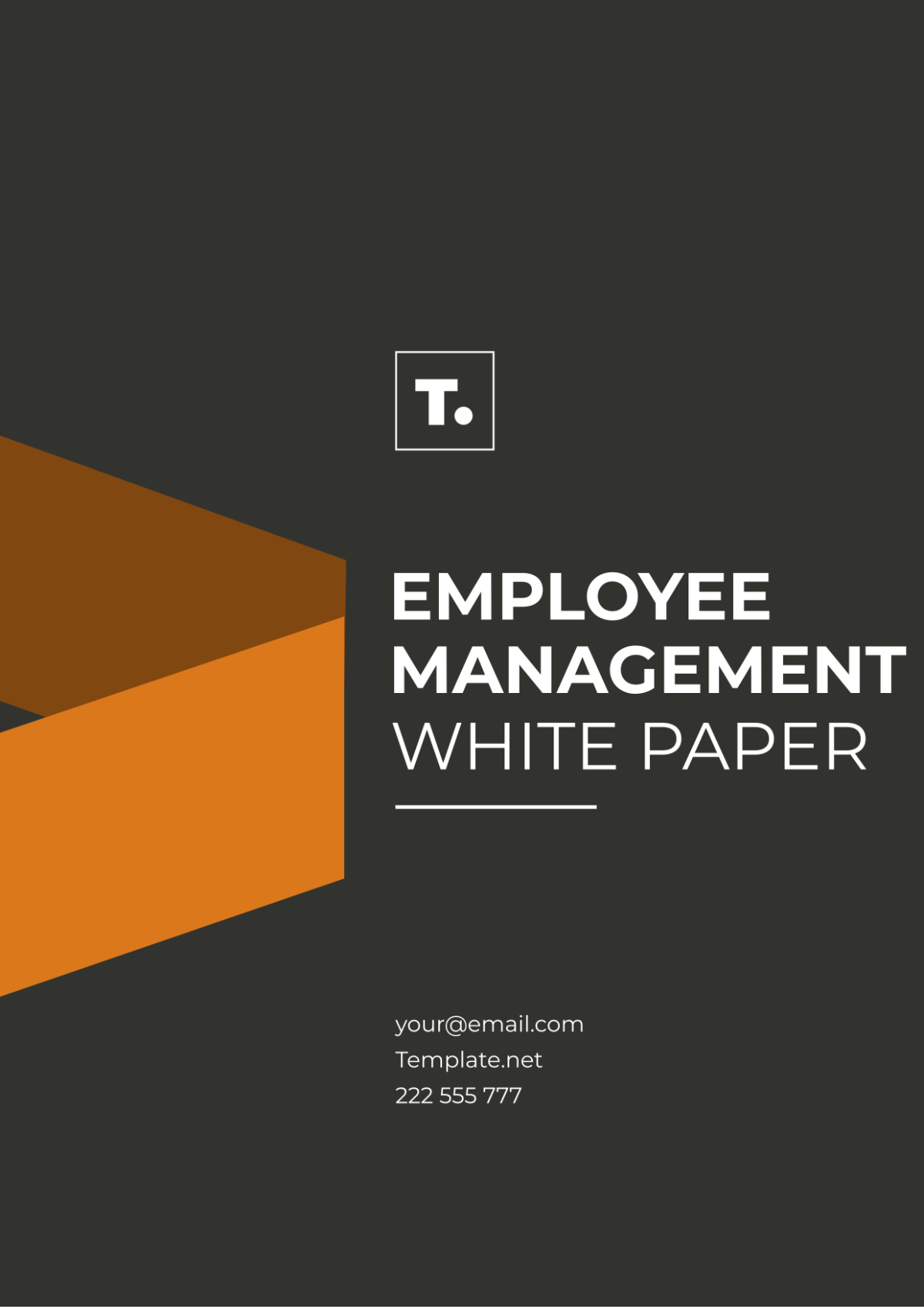Free Employee Management White Paper

Author: [Your Name]
Company: [Your Company Name]
Department: [Your Department]
Date: [Date]
I. Introduction

Effective employee management is the cornerstone of [Your Company Name]'s success, fostering a culture of engagement, productivity, and innovation. This white paper explores proven strategies and best practices for attracting, retaining, and developing top talent in today's competitive business landscape.
II. Talent Acquisition and Recruitment
To build a high-performing workforce, [Your Company Name] must employ strategic talent acquisition and recruitment practices.
A. Employer Branding
Develop a compelling employer brand that communicates [Your Company Name]'s values, culture, and opportunities for professional growth and development.
Leverage social media, employee testimonials, and employer review platforms to enhance [Your Company Name]'s reputation as an employer of choice.
B. Recruitment Strategies
Implement targeted recruitment strategies to attract diverse candidates with the skills, experience, and cultural fit required for success at [Your Company Name].
Utilize a mix of recruitment channels, including job boards, professional networks, employee referrals, and recruitment agencies, to reach a broad pool of qualified candidates.
III. Employee Onboarding and Integration

Effective onboarding is essential to ensure new hires feel welcomed, supported, and equipped to succeed in their roles at [Your Company Name].
A. Onboarding Process
Develop a structured onboarding program that introduces new employees to [Your Company Name]'s mission, values, policies, and procedures.
Provide comprehensive training and resources to help new hires acclimate to their roles and responsibilities and foster a sense of belonging within the organization.
B. Mentorship and Support
Pair new employees with experienced mentors or buddies who can provide guidance, support, and feedback during the onboarding process.
Encourage open communication and regular check-ins to address any questions, concerns, or challenges new hires may encounter.
IV. Performance Management and Development
Ongoing performance management and development are critical to maximizing employee potential and driving organizational success.
A. Goal Setting and Feedback
Establish clear performance expectations and goals aligned with [Your Company Name]'s strategic objectives, and provide regular feedback and coaching to help employees achieve their targets.
Implement performance appraisal processes that recognize and reward employees for their contributions and encourage continuous improvement.
B. Learning and Development
Offer a variety of learning and development opportunities, including training programs, workshops, and online courses, to enhance employees' skills, knowledge, and competencies.
Support career advancement and progression through internal mobility programs, mentorship initiatives, and leadership development pathways.
V. Employee Engagement and Retention
Engaged and satisfied employees are more likely to stay with [Your Company Name] and contribute positively to its success.
A. Employee Recognition and Rewards
Recognize and reward employees for their achievements, contributions, and commitment to [Your Company Name]'s goals and values.
Implement incentive programs, bonuses, and other rewards to motivate and retain top performers and foster a culture of appreciation and recognition.
B. Work-Life Balance and Well-being
Promote work-life balance by offering flexible work arrangements, wellness programs, and support services to help employees manage their personal and professional responsibilities.
Create a supportive and inclusive work environment that prioritizes employee well-being, mental health, and overall satisfaction.
VI. Training & Development
Ensuring continuous professional development is key to retaining top talent and enhancing workforce productivity. This section discusses the training programs that have a high impact on employee performance.
Program | Description | Expected Outcome |
|---|---|---|
Leadership Development | Training sessions aimed at cultivating leadership skills. | Improved team management and decision-making. |
Technical Skills Enhancement | Regular updates and training in specific technical fields relevant to the employee's job role. | Increased productivity and better problem-solving capabilities. |
Soft Skills Training | Programs to enhance communication, negotiation, and interpersonal skills. | Better team dynamics and client relationships. |
VII. Conclusion
By implementing the strategies outlined in this white paper, [Your Company Name] can optimize its employee management practices and cultivate a thriving and engaged workforce. Remember, employees are [Your Company Name]'s most valuable asset, and investing in their recruitment, development, and retention is essential to achieving long-term success and competitive advantage.
VIII. References
Society for Human Resource Management. (2023). "Employee Engagement and Retention Trends Report." Retrieved from www.shrm.org/engagement-retention-trends.
Bersin, J. (2018). "The Future of Work: Trends in Learning and Development." Harvard Business Review, 96(4), 76-84.
Gallup. (2022). "State of the Global Workplace Report." Retrieved from www.gallup.com/workplace.
- 100% Customizable, free editor
- Access 1 Million+ Templates, photo’s & graphics
- Download or share as a template
- Click and replace photos, graphics, text, backgrounds
- Resize, crop, AI write & more
- Access advanced editor
Revolutionize your workforce management with our Employee Management White Paper Template, a comprehensive solution crafted for HR professionals. Seamlessly blending practicality and aesthetics, it offers a platform to articulate strategies for employee engagement and retention. Customizable and downloadable, this template, offered by Template.net, empowers you to convey your vision with clarity. Editable in our AI Editor Tool, transform your insights into actionable plans, ready for dissemination.
You may also like
- Employee Letter
- Employee ID Card
- Employee Checklist
- Employee Certificate
- Employee Report
- Employee Training Checklist
- Employee Agreement
- Employee Contract
- Employee Training Plan
- Employee Incident Report
- Employee Survey
- Employee of the Month Certificate
- Employee Development Plan
- Employee Action Plan
- Employee Roadmap
- Employee Poster
- Employee Form
- Employee Engagement Survey





























